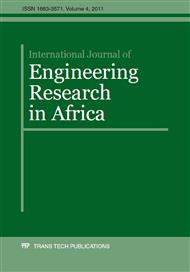[1]
Y. F Makogan, S.A. Holditch, T. Y Makogan, Natural gas hydrates – a potential energy source for the 21st century, J. Petrol. Sci. Eng. 56 (2007) 14-31.
Google Scholar
[2]
U.P. Igboanusi, Properties and production of natural gas hydrates, PhD Thesis, Department of Chemical Engineering, Imperial College London, (2010).
Google Scholar
[3]
K.A. Kvenvolden, Natural gas hydrates: background and history of discovery, in E. D Max (Ed. ), Natural Gas Hydrate in Oceanic and Permafrost Environments, Kluwer Academic Publishers, Netherlands, 2000, pp.9-16.
DOI: 10.1007/978-94-011-4387-5_2
Google Scholar
[4]
E.D. Sloan, Fundamental principles and applications of natural gas hydrates, Nature 426, (2003) 353-359.
DOI: 10.1038/nature02135
Google Scholar
[5]
I. Chatti, A. Delahaye, L. Fournaison, J. Petitet, Benefits and drawbacks of clathrate hydrates: a review of their areas of interest, Energ. Convers. Manag. 46, (2005) 1333 – 1343.
DOI: 10.1016/j.enconman.2004.06.032
Google Scholar
[6]
E.D. Sloan, Clathrate Hydrate of Natural Gases, Marcel Dekker Incorporated, New York, (1998).
Google Scholar
[7]
R. A Dawe, S. Thomas, A large potential methane source – natural gas hydrates, Energy Sources, Part A 29 (2007). 217-229.
DOI: 10.1080/009083190948676
Google Scholar
[8]
Y.F. Makogan, Hydrates of Natural Gas, Penn Well: Oklahoma, (1997).
Google Scholar
[9]
A.V. Milkov, Global estimates of hydrate-bound gas in marine sediments: how much is really out there?, Earth Sci. Rev. 46 (2004) 183 – 197.
DOI: 10.1016/j.earscirev.2003.11.002
Google Scholar
[10]
J.B. Klauda, S.I. Sandler, Global Distribution of Methane Hydrate in Ocean Sediment, Energ. Fuel. 19 (2005) 459 – 470.
DOI: 10.1021/ef049798o
Google Scholar
[11]
C.A. Koh, E.D. Sloan, Natural gas hydrates: recent advances and challenges in energy and environmental applications, AIChE Journal 53 (2007) 1636 – 1643.
DOI: 10.1002/aic.11219
Google Scholar
[12]
P. Englezos, Clathrate hydrates, Ind. Eng. Chem. Res. 32 (2003) 1251-1274.
DOI: 10.1021/ie00019a001
Google Scholar
[13]
R. Corfield, Close encounters with crystalline gas, Chem. Brit. 38 (2002) 22-25.
Google Scholar
[14]
L.D. Valentine, D.C. Blanton, W.S. Reeburgh, M. Kastner, Water column methane oxidation adjacent to an area of active hydrate dissociation, Eel River Basin, Geochim. Cosmochim. Acta 65 (2001) 2633 – 2640.
DOI: 10.1016/s0016-7037(01)00625-1
Google Scholar
[15]
B. Beauchamp, Natural gas hydrates: myths, facts and issues, C. R. Geosci. 336 (2004) 751-765.
DOI: 10.1016/j.crte.2004.04.003
Google Scholar
[16]
C.K. Paull, W. Ussler, W.P. Dillon, Potential role of gas hydrate decomposition in generating submarine slope failures, in E.D. Max (Ed), Natural Gas Hydrate in Oceanic and Permafrost Environments, Kluwer Academic Publishers, Netherlands, 2000, 149 – 156.
DOI: 10.1007/978-94-011-4387-5_12
Google Scholar
[17]
N. Sultan, P. Cochonat, J.P. Foucher, J. Mienert, Effect of gas hydrate melting on seafloor slope stability, Marine Geology 213 (2004) 379 – 401.
DOI: 10.1016/j.margeo.2004.10.015
Google Scholar
[18]
C. Berndt, S. Brune, E. Nisbet, J. Zschau, S.V. Sobolev, Tsunami modelling of a submarine landslide in the Fram Strait, Geochem. Geophy. Geosys. 10 (2009) 1-9.
DOI: 10.1029/2008gc002292
Google Scholar
[19]
S. Nakano, K. Yamamoto, K. Ohgaki, Natural gas exploitation by carbon dioxide from gas hydrate fields – high-pressure phase equilibrium for an ethane hydrate system, Proceed. Inst. Mech. Eng. 212 (1998) 159-163.
DOI: 10.1243/0957650981536826
Google Scholar
[20]
M. Ota, Y. Abe, M. Watanabe, R.L. Smith, H. Inomata, Methane recovery from methane hydrate using pressurized CO2, Fluid Phase Equi. 228-229 (2005) 553-559.
DOI: 10.1016/j.fluid.2004.10.002
Google Scholar
[21]
Y. Kaya, The role of CO2 removal and disposal, Energ. Convers. Manag. 36 (1995) 375-580.
Google Scholar
[22]
K.A. Kvenvolden, Methane hydrate in the global organic carbon cycle, Terra Nova 14 (2002) 302 – 306.
DOI: 10.1046/j.1365-3121.2002.00414.x
Google Scholar
[23]
M.D. Max, Hydrate resource, methane fuel, and a gas-based economy?, in M.D. Max, (Ed. ), Natural Gas Hydrate in Oceanic and Permafrost Environments, Kluwer Academic Publishers, Netherlands, 2000, p.361 – 370.
DOI: 10.1007/978-94-011-4387-5_27
Google Scholar
[24]
N. Goel, In situ methane hydrate dissociation with carbon dioxide sequestration: current knowledge and issues, J. Petrol. Sci. Eng. 51 (2006) 169-184.
DOI: 10.1016/j.petrol.2006.01.005
Google Scholar
[25]
P. Wellsbury, R.J. Parkes, Deep biosphere: sources of methane for oceanic hydrate, in E.D. Max (Ed. ), Natural Gas Hydrate in Oceanic and Permafrost Environments, Kluwer Academic Publishers, Netherlands, 2000, 91 – 104.
DOI: 10.1007/978-94-011-4387-5_8
Google Scholar
[26]
J.M. Brooks, W.R. Bryant, B.B. Bernard, N.R. Cameron, The nature of gas hydrates on the Nigerian continental slope, Annals of the New York Academy of Science, Third International Conference on Gas Hydrates, Park City, Utah, July 18-22, (1999).
DOI: 10.1111/j.1749-6632.2000.tb06761.x
Google Scholar
[27]
J.S. Booth, M.M. Rowe, K.M. Fisher, Offshore Gas Hydrate Sample Database, USGS Open-file Report (1996) 96-272.
DOI: 10.3133/ofr96272
Google Scholar


